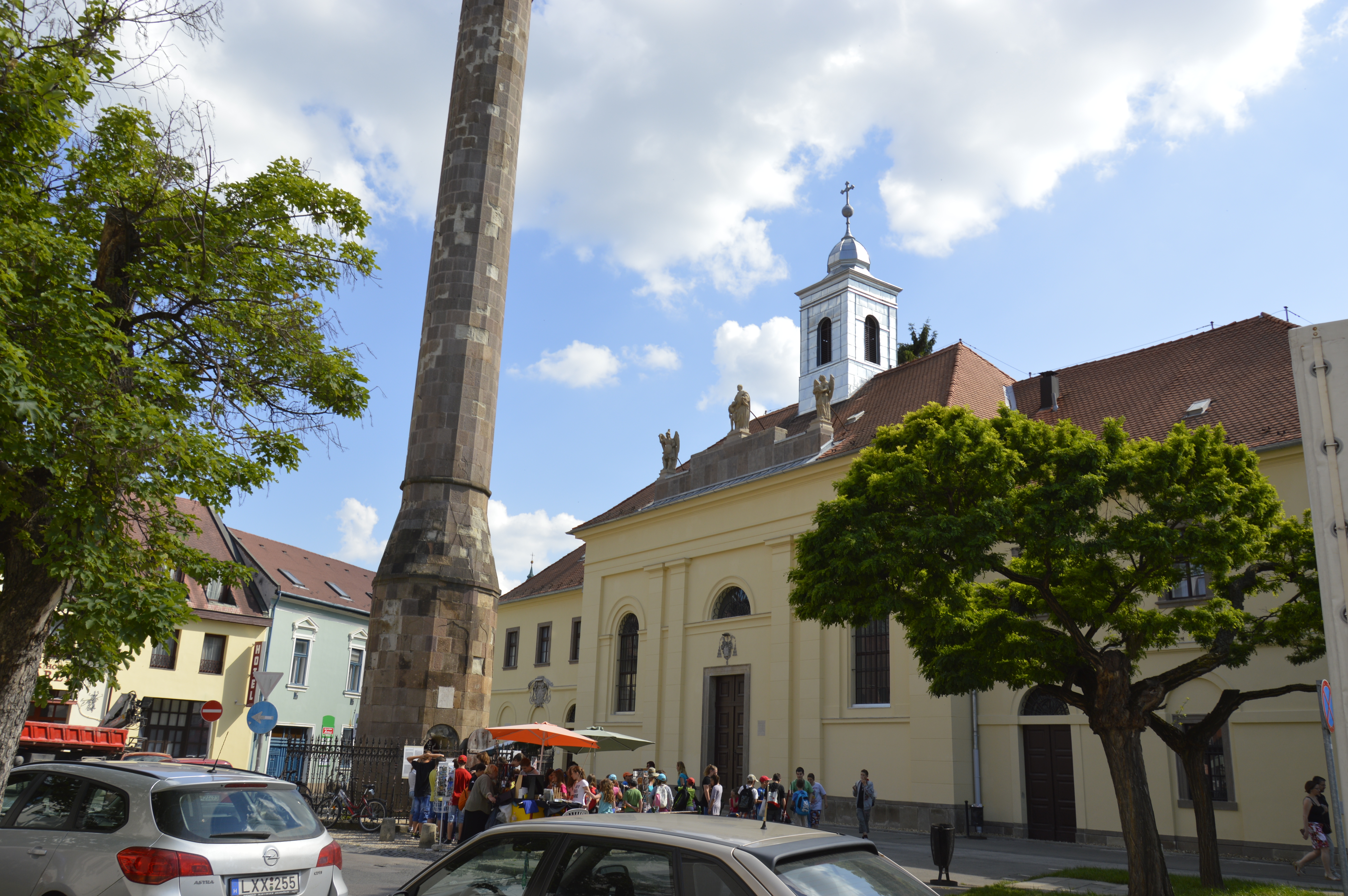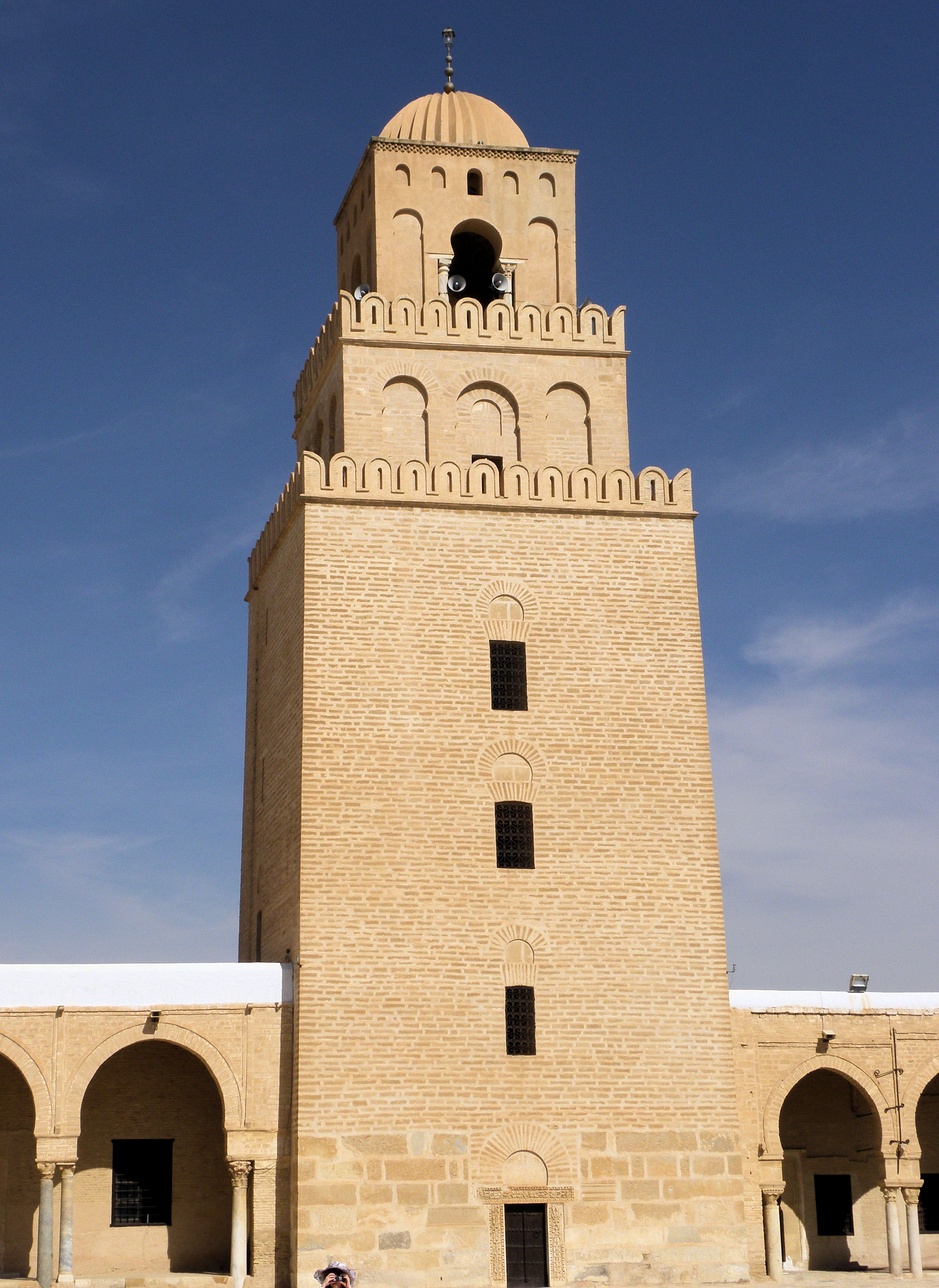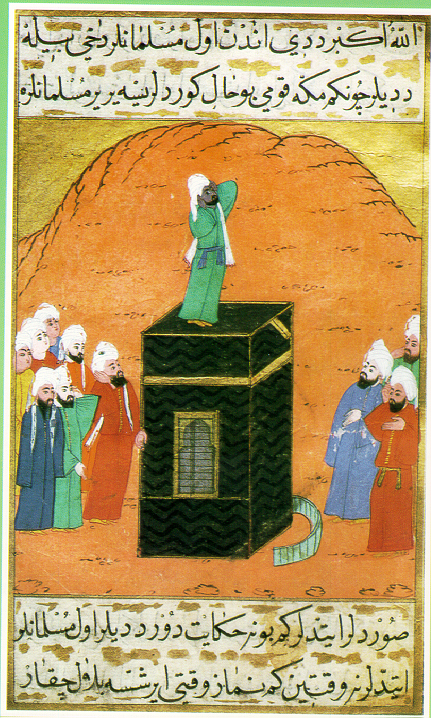|
Eger Minaret
The Eger minaret ( Hungarian: Egri minaret or Kethüda-minaret) is an Ottoman era minaret tower located in Eger city, northern Hungary. It is one of the most northern minarets left from Ottoman rule in Europe. The minaret is 40 metres (131 feet) high and built from red sandstone. It was built in the early 17th century as part of the Djami of Kethuda mosque and used for the Muslim call to prayer (Adhan). The mosque no longer exists, but the minaret survives as a preserved monument of Hungary and a major tourist attraction of Eger. There are 98 steps on the spiral staircase inside, which leads to a balcony at 26 meters from the ground offering unique views of the surrounding city. Eger minaret is one of three surviving Ottoman era minarets in Hungary. It is the highest and the best preserved of them. The other two minarets are the Érd minaret and the minaret of Yakovalı Hasan Paşa Mosque in Pécs. In 2016, a Turkish Muslim resident of Eger was permitted to call the Muslim praye ... [...More Info...] [...Related Items...] OR: [Wikipedia] [Google] [Baidu] |
Eger
Eger ( , ; ; also known by other alternative names) is the county seat of Heves County, and the second largest city in Northern Hungary (after Miskolc). A city with county rights. Eger is best known for its castle, thermal baths, baroque buildings, the northernmost Ottoman minaret, dishes and red wines. Its population of around 53,000 makes it the 19th largest centre of population in Hungary according to the census. The town is located on the Eger Stream, on the hills of the Bükk Mountains. Names and etymology The origin of its name is still unknown. One suggestion is that the place was named after the alder ( in Hungarian) which grew so abundantly along the banks of the Eger Stream. This explanation seems to be correct because the name of the town reflects its ancient natural environment, and also one of its most typical plants, the alder, large areas of which could be found everywhere on the marshy banks of the Stream although they have since disappeared. The German nam ... [...More Info...] [...Related Items...] OR: [Wikipedia] [Google] [Baidu] |
Érd Minaret
The Érd minaret ( Hungarian: Érdi minaret) is an Ottoman era minaret tower situated in Érd near capital Budapest in Hungary. It is one of only three Ottoman era minarets still surviving in Hungary. The other two are the Eger minaret and the minaret of Yakovalı Hasan Paşa Mosque in Pécs. The minaret is 23 metres (75 feet) tall and constructed with limestone. It was built in the 17th century as part of a mosque by Ottoman Muslims Muslims ( ar, المسلمون, , ) are people who adhere to Islam, a monotheistic religion belonging to the Abrahamic tradition. They consider the Quran, the foundational religious text of Islam, to be the verbatim word of the God of Abrah ... and use for the Muslim call to prayer ( Adhan). The minaret is a registered monument of Hungary with identification 7014 and reference number 7012. The minaret stands alone in Érd-Ófalu, near the dam of the Danube, next to a trace of an ancient Roman military road (Mecset Street). History The min ... [...More Info...] [...Related Items...] OR: [Wikipedia] [Google] [Baidu] |
Minarets In Hungary
A minaret (; ar, منارة, translit=manāra, or ar, مِئْذَنة, translit=miʾḏana, links=no; tr, minare; fa, گلدسته, translit=goldaste) is a type of tower typically built into or adjacent to mosques. Minarets are generally used to project the Muslim call to prayer ('' adhan''), but they also served as landmarks and symbols of Islam's presence. They can have a variety of forms, from thick, squat towers to soaring, pencil-thin spires. Etymology Two Arabic words are used to denote the minaret tower: ''manāra'' and ''manār''. The English word "minaret" originates from the former, via the Turkish version (). The Arabic word ''manāra'' (plural: ''manārāt'') originally meant a "lamp stand", a cognate of Hebrew '' menorah''. It is assumed to be a derivation of an older reconstructed form, ''manwara''. The other word, ''manār'' (plural: ''manā'ir'' or ''manāyir''), means "a place of light". Both words derive from the Arabic root ''n-w-r'', which has a ... [...More Info...] [...Related Items...] OR: [Wikipedia] [Google] [Baidu] |
Buildings And Structures In Eger
A building, or edifice, is an enclosed structure with a roof and walls standing more or less permanently in one place, such as a house or factory (although there's also portable buildings). Buildings come in a variety of sizes, shapes, and functions, and have been adapted throughout history for a wide number of factors, from building materials available, to weather conditions, land prices, ground conditions, specific uses, prestige, and aesthetic reasons. To better understand the term ''building'' compare the list of nonbuilding structures. Buildings serve several societal needs – primarily as shelter from weather, security, living space, privacy, to store belongings, and to comfortably live and work. A building as a shelter represents a physical division of the human habitat (a place of comfort and safety) and the ''outside'' (a place that at times may be harsh and harmful). Ever since the first cave paintings, buildings have also become objects or canvasses of much artistic ... [...More Info...] [...Related Items...] OR: [Wikipedia] [Google] [Baidu] |
List Of Oldest Minarets
This article lists some but by no means all of the oldest known minaret towers in the world. The oldest minaret still surviving is that of the Great Mosque of Kairouan in Tunisia. It was constructed in 836 AD and is considered as the prototype for all the square shaped minarets built in the Western Muslim World. Most ancient, surviving minarets were constructed adjacent to a mosque, for the Muslim call to prayer (Adhan) five times each day by a muezzin (crier). A few minarets were built as watchtowers, landmarks or symbols of victory or glory of a Muslim Khanate or empire. In some instances, like the Minaret of Jam only the minaret tower survives today while the adjoining mosques and other structures were destroyed over time by nature and invaders. List of oldest minarets This list ranks the oldest surviving minarets in the world. Only minarets built before 1900 AD. are included. See also *Minaret *List of tallest minarets *List of tallest mosques A list of the tallest m ... [...More Info...] [...Related Items...] OR: [Wikipedia] [Google] [Baidu] |
Ottoman Hungary
Ottoman Hungary ( hu, Török hódoltság) was the southern and central parts of what had been the Kingdom of Hungary in the late medieval period, which were conquered and ruled by the Ottoman Empire from 1541 to 1699. The Ottoman rule covered almost the entire region of the Great Hungarian Plain (except the northeastern parts) and Southern Transdanubia. The territory was invaded and annexed to the Ottoman Empire by Sultan Suleiman the Magnificent between 1521 and 1541. The north-western rim of the Hungarian kingdom remained unconquered and recognised members of the House of Habsburg as Kings of Hungary, giving it the name " Royal Hungary". The boundary between the two thereupon became the frontline in the Ottoman–Habsburg wars over the next 150 years. Following the defeat of the Ottomans in the Great Turkish War, most of Ottoman Hungary was ceded to the Habsburgs under the Treaty of Karlowitz in 1699. During the period of Ottoman rule, Hungary was divided for administrati ... [...More Info...] [...Related Items...] OR: [Wikipedia] [Google] [Baidu] |
Mecca
Mecca (; officially Makkah al-Mukarramah, commonly shortened to Makkah ()) is a city and administrative center of the Mecca Province of Saudi Arabia, and the Holiest sites in Islam, holiest city in Islam. It is inland from Jeddah on the Red Sea, in a narrow valley above sea level. Its last recorded population was 1,578,722 in 2015. Its estimated metro population in 2020 is 2.042million, making it the List of cities in Saudi Arabia by population, third-most populated city in Saudi Arabia after Riyadh and Jeddah. Pilgrims more than triple this number every year during the Pilgrimage#Islam, pilgrimage, observed in the twelfth Islamic calendar, Hijri month of . Mecca is generally considered "the fountainhead and cradle of Islam". Mecca is revered in Islam as the birthplace of the Prophets and messengers in Islam, Islamic prophet Muhammad. The Hira cave atop the ("Mountain of Light"), just outside the city, is where Muslims believe the Quran was first revealed to Muhammad. Vis ... [...More Info...] [...Related Items...] OR: [Wikipedia] [Google] [Baidu] |
Eger - Minaret - Panoramio (2)
Eger ( , ; ; also known by other alternative names) is the county seat of Heves County, and the second largest city in Northern Hungary (after Miskolc). A city with county rights. Eger is best known for its castle, thermal baths, baroque buildings, the northernmost Ottoman minaret, dishes and red wines. Its population of around 53,000 makes it the 19th largest centre of population in Hungary according to the census. The town is located on the Eger Stream, on the hills of the Bükk Mountains. Names and etymology The origin of its name is still unknown. One suggestion is that the place was named after the alder ( in Hungarian) which grew so abundantly along the banks of the Eger Stream. This explanation seems to be correct because the name of the town reflects its ancient natural environment, and also one of its most typical plants, the alder, large areas of which could be found everywhere on the marshy banks of the Stream although they have since disappeared. The German n ... [...More Info...] [...Related Items...] OR: [Wikipedia] [Google] [Baidu] |
Muezzin
The muezzin ( ar, مُؤَذِّن) is the person who proclaims the call to the daily prayer ( ṣalāt) five times a day (Fajr prayer, Zuhr prayer, Asr prayer, Maghrib prayer and Isha prayer) at a mosque. The muezzin plays an important role in ensuring an accurate prayer schedule for the Muslim community. Etymology The English word ''muezzin'' is derived from the ar, مُؤَذِّن, , simplified ''mu'azzin''. The word means "one by the ear", since the word stems from the word for "ear" in Arabic is ''ʾudhun'' (أُذُن). As the ''muʾadh·dhin'' will place both hands on his ears to recite the call to prayer. Roles and responsibilities The professional muezzin is chosen for his good character, voice and skills to serve at the mosque. However, the muezzin is not considered a cleric, but in a position comparable to a Christian verger. He is responsible for keeping the mosque clean, for rolling the carpets, for cleaning the toilets and the place where people wash the ... [...More Info...] [...Related Items...] OR: [Wikipedia] [Google] [Baidu] |
Evliya Çelebi
Derviş Mehmed Zillî (25 March 1611 – 1682), known as Evliya Çelebi ( ota, اوليا چلبى), was an Ottoman explorer who travelled through the territory of the Ottoman Empire and neighboring lands over a period of forty years, recording his commentary in a travelogue called the '' Seyâhatnâme'' ("Book of Travel"). The name Çelebi is an honorific title meaning "gentleman" or "man of God" (see pre-1934 Turkish naming conventions). Life Evliya Çelebi was born in Constantinople in 1611 to a wealthy family from Kütahya. Both his parents were attached to the Ottoman court, his father, Derviş Mehmed Zilli, as a jeweller, and his mother as an Abkhazian relation of the grand vizier Melek Ahmed Pasha. In his book, Evliya Çelebi traces his paternal genealogy back to Ahmad Yasawi, an early Sufi mystic. Evliya Çelebi received a court education from the Imperial ''ulama'' (scholars). He may have joined the Gulshani Sufi order, as he shows an intimate knowledge of their ... [...More Info...] [...Related Items...] OR: [Wikipedia] [Google] [Baidu] |







